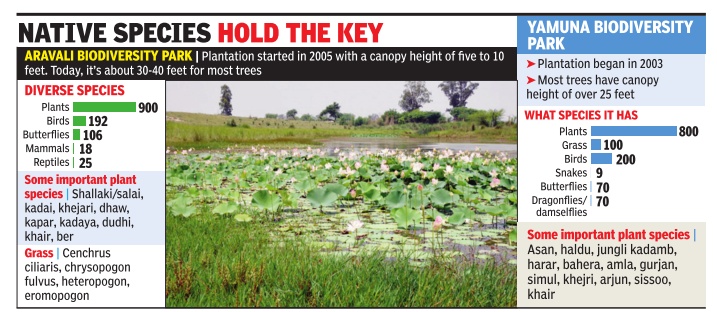Delhi: Flora, forests
| Line 12: | Line 12: | ||
[[File: Some facts, Native species, Delhi.jpg|Species native to Delhi/NCR; Graphic courtesy: [http://epaperbeta.timesofindia.com/Gallery.aspx?id=06_08_2015_002_035_009&type=P&artUrl=Aravali-Yamuna-biodiversity-parks-show-the-way-06082015002035&eid=31808 ''The Times of India''], August 6, 2015|frame|500px]] | [[File: Some facts, Native species, Delhi.jpg|Species native to Delhi/NCR; Graphic courtesy: [http://epaperbeta.timesofindia.com/Gallery.aspx?id=06_08_2015_002_035_009&type=P&artUrl=Aravali-Yamuna-biodiversity-parks-show-the-way-06082015002035&eid=31808 ''The Times of India''], August 6, 2015|frame|500px]] | ||
| + | |||
| + | =Decline in green cover: 1986-2015= | ||
| + | [http://epaperbeta.timesofindia.com/Article.aspx?eid=31808&articlexml=Overall-decline-in-green-cover-since-1986-Study-30082015024062 ''The Times of India''], Aug 30 2015 | ||
| + | |||
| + | '''Overall decline in green cover since 1986: Study''' | ||
| + | | ||
| + | A recent study on the city's green cover shows a disturbing trend. Delhi's vegetation has seen an overall decline since 1986.The green cover is also increasingly becoming fragmented, the study reveals.The highest fragmentation is being seen on the periphery where afforestation work is being conducted to compensate for the loss of trees to urban development projects. However, it is also only on the periphery that the green cover is increasing while the same is on the wane in the core and transitional areas. | ||
| + | The study by Ashoka Trust for Research in Ecology and Environment (ATREE), Manipal Academy of Higher Education and Azim Premji University , highlights that though vegetation is increasing on the periphery, rapid urbanization and expanding real estate business could put this in danger. “Farm lands, wetlands, open spaces and trees on the periphery have been rapidly converted into urban built-up areas. With this, the vegetated landscape of Delhi is becoming increasingly fragmented like Shenzen, Daqing and Mumbai“ the study states. | ||
| + | |||
| + | For instance, the green cover in Delhi's core area in 1986 was about 64.68%, but it reduced to about 43.98% in 2010. Vegetation in the transitional area was 25.32% which marginally reduced to 22.43% but the peripheral green cover increased from 13.22% in 1986 to 16.52% in 2010. | ||
| + | |||
| + | “My study shows that there is an overall decline in the green cover in the past 25 years and the vegetated landscape is increasingly becoming fragmented. But when we look at different zones, we find that the core has maximum vegetation but it is also declining since 1986. The transitional zone has lesser proportion of vegetation than the core area. Though there has been a slight increase in the green cover in this zone from 1986 to 1999, the period between 2000 and 2010 saw a steady decline,“ said Somajita Paul, co-author of the study , which was conducted using satellite images for all these years. | ||
Revision as of 17:20, 31 August 2015

This is a collection of articles archived for the excellence of their content. |

Decline in green cover: 1986-2015
The Times of India, Aug 30 2015
Overall decline in green cover since 1986: Study A recent study on the city's green cover shows a disturbing trend. Delhi's vegetation has seen an overall decline since 1986.The green cover is also increasingly becoming fragmented, the study reveals.The highest fragmentation is being seen on the periphery where afforestation work is being conducted to compensate for the loss of trees to urban development projects. However, it is also only on the periphery that the green cover is increasing while the same is on the wane in the core and transitional areas. The study by Ashoka Trust for Research in Ecology and Environment (ATREE), Manipal Academy of Higher Education and Azim Premji University , highlights that though vegetation is increasing on the periphery, rapid urbanization and expanding real estate business could put this in danger. “Farm lands, wetlands, open spaces and trees on the periphery have been rapidly converted into urban built-up areas. With this, the vegetated landscape of Delhi is becoming increasingly fragmented like Shenzen, Daqing and Mumbai“ the study states.
For instance, the green cover in Delhi's core area in 1986 was about 64.68%, but it reduced to about 43.98% in 2010. Vegetation in the transitional area was 25.32% which marginally reduced to 22.43% but the peripheral green cover increased from 13.22% in 1986 to 16.52% in 2010.
“My study shows that there is an overall decline in the green cover in the past 25 years and the vegetated landscape is increasingly becoming fragmented. But when we look at different zones, we find that the core has maximum vegetation but it is also declining since 1986. The transitional zone has lesser proportion of vegetation than the core area. Though there has been a slight increase in the green cover in this zone from 1986 to 1999, the period between 2000 and 2010 saw a steady decline,“ said Somajita Paul, co-author of the study , which was conducted using satellite images for all these years.